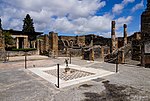Boscotrecase
Boscotrecase (Italian pronunciation: [bɔskotre(k)ˈkaːse, -aːze]]) is a comune (municipality) in the Metropolitan City of Naples in the Italian region Campania, located about 20 km southeast of Naples. Boscotrecase, which many considered a resort, sat on the southern slopes of Mount Vesuvius and was home to many villas and farmhouses. One of these villas was the villa at Boscotrecase, a villa owned by Agrippa, general and right-hand man of Emperor Augustus, and his wife Julia. In 79 A.D. an eruption from Vesuvius buried the villa at Boscotrecase, also known as the Villa of Agrippa Postumus, the Imperial Villa, and the Villa of Augusta. The villa is best known for its ancient Roman works of art, especially its frescoes. Because the ash from Mount Vesuvius's eruption preserved the frescoes, they were able to be excavated between 1903 and 1905. The frescoes come from various cubicula, or bedrooms that served as places of sociability and business, along the villa's southern hallway that overlooks the bay of Naples.The frescoes that were excavated are now shared between the Metropolitan Museum of Art and the National Archaeological Museum of Naples. A fragment from the villa was discovered in the collection of the Harvard Art Museums in 2007. It was acquired in 1921 from Albert Gallatin.
Excerpt from the Wikipedia article Boscotrecase (License: CC BY-SA 3.0, Authors).Boscotrecase
Via Panoramica,
Geographical coordinates (GPS) Address Nearby Places Show on map
Geographical coordinates (GPS)
| Latitude | Longitude |
|---|---|
| N 40.783333333333 ° | E 14.466666666667 ° |
Address
Via Panoramica
Via Panoramica
80042
Campania, Italy
Open on Google Maps











